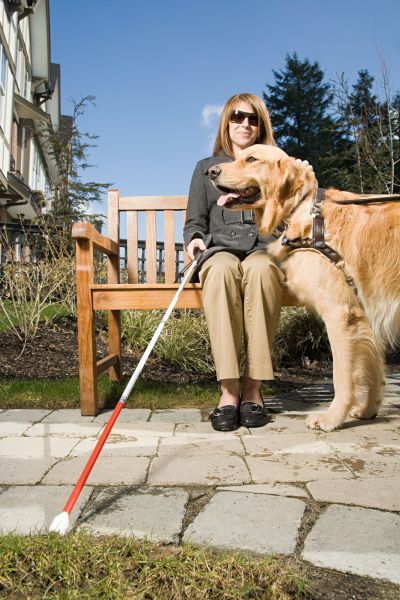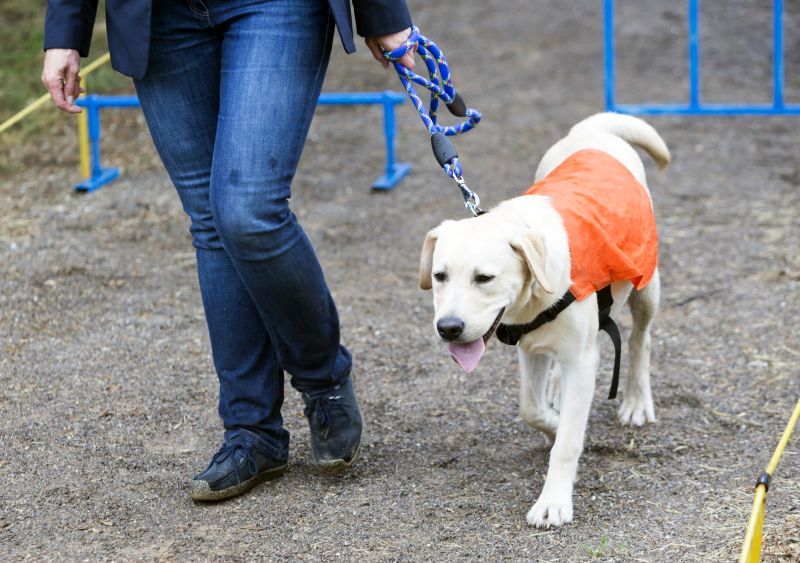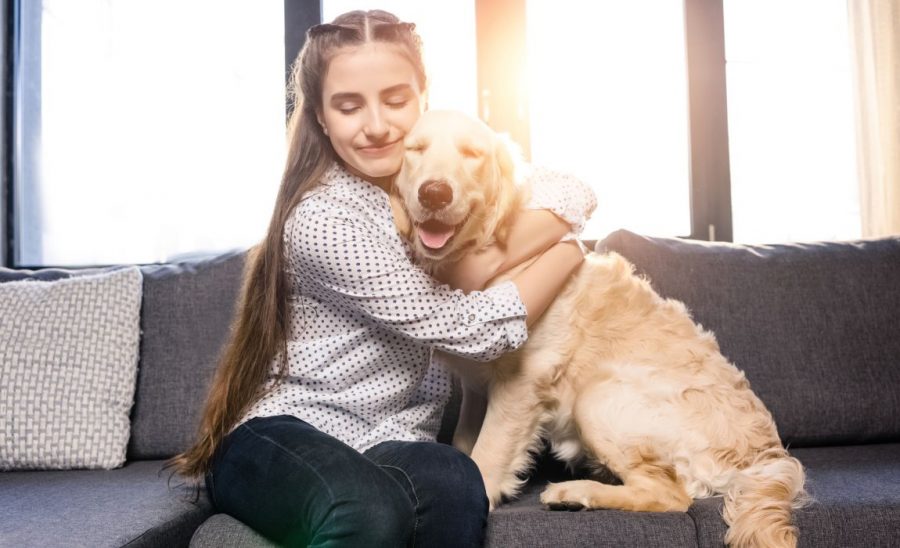Dogs are natural sweethearts — most furry friends provide their owners with emotional support through cuddling, companionship, and quality time. However, some owners have mental health needs which exceed the run-of-the-mill desire for love and companionship.
In some cases, people struggling with mental health challenges may be encouraged by mental health professionals to seek companionship from an emotional support animal, or ESA for short.
We’ll explain everything you need to know about ESAs below including the particular registration requirements.
How to Register Your Dog as an ESA: Key Takeaways
- Emotional support animals (ESAs) are pets that mental health professionals prescribe for their patients. These animals help their people cope with mental health challenges by doing things like providing love and easing anxiety.
- It is important to understand that ESAs are pets, not service animals. This means ESAs are not trained to perform specific tasks (such as leading blind owners), nor do they enjoy the same rights and privilege’s service animals do.
- To obtain an ESA, you’ll need to obtain a “prescription” letter from a mental health professional. You don’t need to “register” your ESA with any organization, but registering your dog as an ESA through a service like CertaPet or Pettable can make the process feel more official and may make landlords less likely to challenge your dog’s status.
What Is an Emotional Support Dog?

Emotional support animals are pets that help their people cope with mental health challenges. Dogs are the most common examples (and the ones we’ll be focusing on here), but ESAs come in all shapes, sizes, and species.
But while they are classified as pets, ESAs differ from typical family four-footers.
For example, plenty of pups offer emotional support to their owners, but ESAs are prescribed by mental health professionals for their patients. Essentially, the therapist, psychiatrist, or psychologist determines that an emotional support animal is needed for the mental health and well being of a patient.
Emotional support dogs can be any age or breed, so long as they are actively alleviating some of the symptoms associated with an individual’s mental health challenges.
This could be easing someone’s anxiety or stress, providing structure and focus through a routine, or any of the other mental health benefits pooches often provide.
Is an Emotional Support Dog the Same as a Service Dog?
Service dogs and emotional support animals share some similarities, but they are entirely different classifications altogether.
While both ESAs and service dogs can provide emotional support for their owners, service dogs are trained to perform a specific task in relation to their owner’s disability. These tasks are not vague or instinctual (such as general canine cuddling); instead, they are specific to their owner’s needs.

This could be guiding a visually impaired person around an obstacle, or alerting a deaf patient to an alarm.
According to the Americans with Disabilities Act, service animals are strictly those that are trained to perform tasks for people with physical, sensory, psychiatric, intellectual, or other mental disabilities.
Simple companionship or affection does not qualify as a distinguished service task.
Emotional support animals needn’t be trained to perform these types of specific tasks (but training an ESA never hurts either).
For a dog to be considered an ESA, they simply need to be important for the mental health and well being of their person and recommended by a licensed mental health professional.
That being said, you can still have a service dog for anxiety, if the dog is trained to perform certain behaviors to alleviate anxiety, such as providing physical pressure during a panic attack.
So, while there are obviously some similarities, service dogs and ESAs are clearly very different, and they’re treated very differently under the law.
ESAs and service dogs also differ from therapy dogs, which are pups that are trained to provide affection and comfort to many people, usually in settings like a nursing home, hospital, or disaster areas.
Like emotional support dogs, therapy dogs do not receive the same accommodations as service dogs.
Learn more facts about therapy dogs here!
The Rules and Regulations for Emotional Support Dogs

There are certain rules that emotional support dogs and owners need to follow in order to qualify a pet as an ESA. Here are some things to keep in mind while seeking out an emotional support animal:
- These dogs can be any breed or age. Though some breeds tend to be better service dogs or ESAs than others (for example, some dogs are great at helping to alleviate anxiety), any dog can be an emotional support dog so long as they are prescribed by your licensed mental health professional in relation to your mental health disability.
- An emotional support dog or animal is prescribed by a licensed mental health professional. In order to obtain an emotional support dog or ESA, you need to speak with your therapist or other licensed professional and obtain a letter describing your need for one.
- ESAs do not have the same privileges as service dogs. Emotional support dogs aren’t always allowed into public places in the way that service dogs are since the two groups have entirely different classifications. True service dogs are allowed just about anywhere the public is; ESAs are allowed in some places, but not others.
- Having an ESA cannot prevent you from obtaining housing. The Fair Housing Act qualifies ESAs as assistance animals, meaning that owners and their ESAs cannot be discriminated against when obtaining housing. Pet bans, restrictions, and pet deposits are waived for those who live with ESAs.
- Most airlines no longer accommodate emotional support dogs. The 2020 revision to the Air Carrier Access Act removed the requirement for airlines to accommodate ESAs. As of this year, only service dogs qualify for this classification. A few airlines still accommodate emotional support dogs, but these are few and far between. However, you can still travel with your ESD as a traditional pet so long as they meet the individual airline’s requirements.
How Can I Get an Emotional Support Animal?

In order to get an emotional support animal or have your current canine certified as such, you need to speak with a licensed mental health professional, demonstrate your need for an ESA in relation to your disability, and obtain a letter outlining these facts.
So, if you already receive care from a licensed mental health professional, you can simply discuss an ESA with him or her.
But don’t worry if you don’t currently have a therapist, psychologist, or psychiatrist: There are legitimate organizations that can help you obtain a letter from a licensed mental health professional.
Legitimate Organizations That Can Help You Obtain an Emotional Support Dog
There are a lot of sketchy companies offering unnecessary services (such as registration — more on this in a minute) for people in need of an ESA.
But while you want to steer clear of these shady companies, there are a few legitimate organizations that can help people who don’t have a therapist or psychiatrist obtain an emotional support pet.
We’ll discuss three of the best below.
1. CertaPet

CertaPet offers certificates for travel, housing, or both, thereby allowing you to customize your consultation based on your needs. The service is licensed in all 50 states and also offers a quick free pre-screening to determine if you’re an eligible candidate for an ESA before committing to the entire process.
Features:
- The cost of the certification ranges from $149 to $199 depending on your letter type
- Full consultation turn around usually takes 2 to 3 business days
- You’ll receive an electronic and physical copy of your letter
- If you’re not approved by the licensed professional, you’ll receive a refund (minus the $35 consultation fee)
2. Pettable

Pettable is licensed in all 50 states and offers ESA certification for all pets and owners who qualify via a telehealth consultation.
The service offers a free 3-minute pre-screening to make sure you’re eligible for the service before setting up an in-depth consultation with a licensed professional.
- You can use the “express service” to obtain a letter in as little as 24 hours
- Choose between travel, housing, or bundle certificates, priced between $149 and $199
- Provides legal support for complications with landlords
- Offers a refund if the ESA letter doesn’t work out for whatever reason
3. ESA Certificate
ESA Certificate connects you directly with qualified therapists to obtain a travel, housing, or combination certificate. The service provides an free online questionnaire for pre-screening purposes, and they will mail out a physical letter within 48 hours of the approved consultation session.
Features:
- Select housing, travel, or combination certificates between $149 and $189
- If you need to upgrade your certificate to a combination bundle, you can do so within 60 days of purchase
- Offers an optional “ESA Shield” plan to help mitigate conflict with landlords at an additional price
- Full money-back guarantee if it’s determined that you do not qualify for an ESA
ESA letters are only valid for one year, so you’ll need to go through the process annually. It is a good idea to keep your letters from previous years with your other health records.
Does Your ESA Require a Special Vest?

The ADA does not require assistance animals to wear a vest or be labelled as an ESA. In effect, this means that any dog you see may actually be an emotional support animal.
However, a dog service vest may still be a good idea, since they can help alert others that a furry friend is on duty, and therefore shouldn’t be distracted or engaged with as one might with a typical pet. It may also make business owners and others more likely to accommodate your canine companion.
Additionally, service vests can also contain helpful pockets or compartments to hold medications or other essential items. Many also reflective for extra safety and look great. Some dogs may not like working with a vest, so owners may opt for a bandana, collar, collar, or leash wrap instead.
Do You Need to Register an Emotional Support Dog?

Unfortunately, there are a number of sketchy “emotional support animal registration sites” that seek to take advantage of people who aren’t familiar with ESA requirements.
But let’s be crystal clear: These are not the same thing as the ESA services discussed above.
You do NOT need to register your pet with a registry site — as long you have your licensed letter, you are all set (that is what the organizations above help you accomplish). In fact, there is no national registry for emotional support dogs and animals.
If a service isn’t connecting you directly with a mental health professional, they aren’t worth your time. You aren’t allowed to “buy” ESA letters — they can only be obtained through a formal evaluation.
***
Emotional support dogs can provide plenty of companionship, focus, and structure to the lives of those struggling with a mental disability. These pups aren’t to be confused with service or therapy dogs, and are classified through consultation with your licensed mental health professional by way of a letter.
Do you have an emotional support animal? How does your dog help you? We’d love to hear all about your helpful hound in the comments below!














Leave a Comment